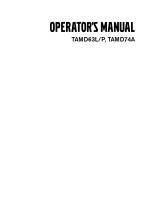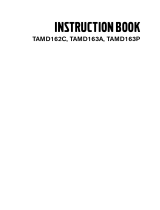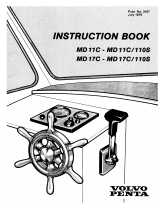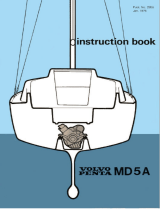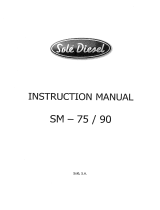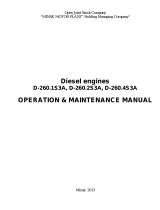Page is loading ...

OPERATOR’S MANUAL
D25A MS/MT
D30A MS/MT
Plus d'informations sur : www.dbmoteurs.fr

CALIFORNIA
Proposition 65 Warning
Diesel engine exhaust and some of its constituents are known
to the State of California to cause cancer, birth defects, and
other reproductive harm.
Plus d'informations sur : www.dbmoteurs.fr

Foreword
Thank you for purchasing this Volvo Penta diesel engine.
This manual contains operation instructions and maintenance and inspection information. In or-
der to ensure safety and bring out the maximum performance of the engine, do not operate the
engine until you have read and fully understood the contents of this manual. Do not hesitate to
consult your Volvo Penta dealer.
Failure to follow the instructions and cautions in this manual may result in serious accidents.
* Keep this manual at hand for easy reference.
* If this manual is damaged or misplaced, immediately order a new copy from your dealer.
Plus d'informations sur : www.dbmoteurs.fr

4
Foreword .................................................................. 3
Safety Information ................................................... 6
Safety regulations during engine operation ............. 7
Safety directions for maintenance and service ....... 8
Warning labels D25A / D30A MS ......................... 10
Warning labels D25A / D30A MT .......................... 11
Introduction ............................................................ 12
Care of the environment ....................................... 12
Fuel and oil .......................................................... 12
Service and spare parts ....................................... 12
Certified engines .................................................. 13
Warranty .............................................................. 13
Presentation ........................................................... 14
D25A/D30A MS ................................................... 14
D25A/D30A MT .................................................... 15
New Engine Initial service ...................................... 16
General ................................................................ 16
External Inspection .............................................. 16
Valves and Plugs ................................................. 16
Electrical Wiring ................................................... 16
Fill Fuel system ................................................... 16
Fill Lubrication system ......................................... 16
Fill Cooling system .............................................. 16
Starting .................................................................. 17
Before starting ..................................................... 17
Warming-up .......................................................... 17
Standard control system ........................................ 18
Instrument panels ................................................ 18
Warning displays .................................................. 19
After an alarm ...................................................... 19
Alarm test ............................................................ 19
Starting switch ..................................................... 19
Starting procedure ................................................ 20
Operation ............................................................. 21
Alarms and fault indication ................................... 22
Stopping the engine ............................................. 22
Emergency stop ................................................... 22
Operation ............................................................... 23
General ................................................................ 23
Applying Load ...................................................... 24
Running in ............................................................ 24
Forced propeller rotation ....................................... 24
Manoeuvring ........................................................ 24
Manual speed control ........................................... 25
Start using auxiliary batteries ............................... 27
Contents
Stopping ................................................................ 28
Manual Stop Lever ............................................... 28
After stopping ........................................................ 29
General ................................................................ 29
Anti-freezing measures ........................................ 29
Breaks in operation [not using the engine]............ 29
Maintenance .......................................................... 30
Maintnenance schedule D25A/D30A MS .............. 31
Maintnenance schedule D25A/D30A MT .............. 34
Overhaul information ............................................ 37
Recommendation of Daily Operation Records ...... 39
Engine ................................................................... 40
Valve Clearance ................................................... 40
Firing order ........................................................... 41
Vibration Damper Inspection ................................ 42
Re-tighten Bolts and Nuts .................................... 42
How to use the Turning Gear ............................... 43
Fuel system ........................................................... 44
Fuel system bleeding ........................................... 44
Fuel filter change ................................................. 46
Fuel tank drain ..................................................... 47
Fuel injection nozzle tip change ........................... 47
Fuel injection pressure ......................................... 48
Injection timing inspection .................................... 50
Fuel control .......................................................... 51
Twin fuel pre-filter/water separator ........................ 52
Lubrication system ................................................. 54
Lubrication oil level check .................................... 54
Lubrication oil filling .............................................. 54
Lubrication oil change .......................................... 56
Oil filter change .................................................... 57
Lubrication oil by-pass filter change ..................... 58
Hydraulic governor oil filter change ....................... 58
Freshwater system ................................................ 59
Coolant level check .............................................. 59
Coolant filling ....................................................... 60
Coolant drain ........................................................ 60
Freshwater system flushing ................................. 61
Seawater system ................................................... 62
Draining the seawater system .............................. 62
Check and Change the zinc anodes ..................... 62
Seawater filter check/change ............................... 62
Seawater pump impeller check/hange .................. 63
Heat exchanger cleaning ...................................... 63
Plus d'informations sur : www.dbmoteurs.fr

5
Air Inlet and Exhaust Systems .............................. 64
Turbocharger Inspection ....................................... 64
Cleaning the Air Cooler ........................................ 64
Check air cooler drain pipe ................................... 64
Wash the air filter ................................................. 65
Electrical system ................................................... 66
Protective Devices Inspection.............................. 66
Check the electrical wiring ................................... 66
Starter motor inspection ....................................... 66
Alternator Inspection ............................................ 66
Drive belts. Check/Adjust/Change ........................ 66
Inhibiting ................................................................ 67
General ................................................................ 67
Preparation .......................................................... 67
Care during storage .............................................. 67
Return the engine to service ................................ 67
Storage of Engine in operating condition .............. 68
Troubleshooting ..................................................... 69
Technical Data ....................................................... 70
D25A MS ............................................................. 70
D25A MT ............................................................. 71
D30A MS ............................................................. 72
D30A MT ............................................................. 73
Fuel specification ................................................. 74
Lubrication oil specification .................................. 75
Coolant specification ............................................ 76
Tightening Torque Tables ..................................... 77
Identification numbers D25A / D30A .................... 83
Sea trial data ....................................................... 84
Plus d'informations sur : www.dbmoteurs.fr

6
Safety Information
Read this chapter thoroughly. It concerns your safety. This section describes how safety information is presented
in this manual and on the product. It also includes a summary of basic safety regulations for operation and main-
tenance of the engine.
Make sure you are in possession of the right operator’s manual before reading on. If this is not the case,
please get in touch with your Volvo Penta dealer.
If operations are performed incorrectly it could result in personal injury or damage to property or the engi-
ne. Read the Operator’s Manual carefully before operating or servicing the engine. If anything is unclear
please contact your Volvo Penta dealer for assistance.
This symbol is used in the book and on the engine to make you aware of safety infor-
mation. Always read these safety precautions very carefully.
In the Operator’s Manual warning texts have the following priority:
WARNING! If these instructions are not followed there is a danger of personal injury,
extensive damage to the product or serious mechanical malfunction.
IMPORTANT! Used to draw your attention to something that can cause damage,
product malfunction or damage to property.
NOTE! Used to draw your attention to important information that will facilitate work or
operations.
This symbol is used in certain cases on our products and refers to important informa-
tion in the Operator’s Manual. Ensure that warning and information symbols on the engine
and transmission are always visible and legible. Replace symbols that have been damaged
or painted over.
Plus d'informations sur : www.dbmoteurs.fr

7
Safety information
Safety regulations during engine operation
Filling fuel
There is a risk of fire and explosion when filling fuel.
Smoking is prohibited and the engine must be turned
off. Never overfill the tank. Close the filler cap
securely. Use only fuel recommended in the operators
manual. The incorrect grade of fuel can disturb opera-
tion or cause breakdown. This can also lead to the
control rod jamming on diesel engines, which will cau-
se the engine to overspeed and risk damaging machi-
nery and causing personal injury.
Combustible enviroment
Due to the risk of fire and/or explosion, do not start or
continue to run the engine if there is a suspected leak
or discharge of combustible media, e.g. fuel oil or
LPG, in the engine surroundings.
Carbon monoxide poisoning
When a vessel is moving forward, it will cause a cer-
tain vacuum to form behind the vessel. In unfortunate
circumstances, the suction from this vacuum can be
so great that the exhaust gases from the vessel are
drawn into the bridge or cabin and cause carbon mon-
oxide poisoning. This problem is most prevalent on
high, wide vessels with abrupt stern. Other factors
that can increase the effect of the suction are wind
conditions, load distribution, swells, trim, open hat-
ches and portholes, etc. Most modern vessels, howe-
ver, are designed in such a way that this problem is
very rare. If suction should arise anyway, do not open
hatches or portholes at the fore of the vessel. Surpri-
singly, this will otherwise increase the suction. Try
changing speed, trim, or load distribution instead. Get
in touch with your Volvo Penta dealer for help in ob-
taining the best solution for your vessel.
The new engine
Read instruction manuals and other information ac-
companying the new vessel thoroughly. Accustom
yourself with handling the engine, controls and other
equipment in a safe and correct manner.
Remember that when operating a vessel, you have a
legal responsibility to be aware of and follow regula-
tions concerning traffic and safety at sea. Inform your-
self of the regulations applicable to your vessel and
the waters your in by getting in touch with the relevant
authorities or marine safety organization.
Accidents and other incidents
Sea rescue statistics show that deficient maintenance
of vessels and engines together with defective safety
equipment often causes accidents and other incidents
at sea.
Make sure your vessel and engine are maintained in
accordance with directions in the instruction manuals
and that the safety equipment on board is in good
working order.
Daily inspection
Make a habit of visually inspecting the engine and
engine room before starting and after stopping the
engine. This will help you to quickly detect any fuel,
coolant or oil leaks and any other abnormalities that
have occurred or are about to occur.
Maneuvering
Avoid violent and rapid rudder movement and gear
shifting. There is a risk of the passengers falling down
or falling overboard. A rotating propeller can cause se-
rious injury. Make sure there is nobody in the water
before engaging forward/reverse. Never run close to
bathers or in places where you have reason to
believe there are people in the water.
Plus d'informations sur : www.dbmoteurs.fr

8
Safety information
Safety directions for maintenance and service
Before starting
Refit all guards and covers that have been removed
before starting the engine. Make sure there are no
tools or other objects left on the engine. A turbochar-
ged engine must never be started without the air filter
fitted. The rotating compressor wheel in the turbochar-
ger can cause severe personal injury.
There is also a risk of foreign objects being drawn in
and causing mechanical damage.
Fire and explosion
Fuel and lubricants
All fuels, most lubricants, and many chemicals are
flammable substances. Always read and follow the
directions on the packaging. Work performed on the
fuel system must be done on a cold engine. Fuel
leaks and spills on hot surfaces or electrical
components can cause fires.
Keep oil- and fuel drenched rags and other hazardous
materials where they are safe in case of fire. Oil dren-
ched rags can selfignite in certain conditions. Never
smoke when refueling, topping up with oil or when in
the vicinity of the fuel station or the engine room.
Non-original parts
Components in fuel, lubrication, ignition and electrical
systems on Volvo Penta engines are designed and
manufactured to minimize the risk of explosion and
fire in compliance with existing legislation.
The use of non-original parts can result in explosion
or fire.
Batteries
Batteries contain and generate oxyhydrogen gas,
especially when charging. Oxyhydrogen is easily
ignited and extremely explosive. Smoking, open fla-
mes and sparks must never occur in, or close to, the
batteries or battery compartment. A faulty battery con-
nection or jumper cable can generate sparks that can
cause the battery to explode.
Start spray
Never use start spray or similar start help. Explosions
can occur in the intake manifold. Risk for personal
injury.
Preparations
Knowledge
The operator’s manual contains directions for perfor-
ming normal maintenance and service in a safe and
correct manner. Read the directions carefully before
starting work. More detailed service literature is avail-
able from your Volvo Penta dealer. Never perform a
task unless you are absolutely sure how it is to be
carried out; call your Volvo Penta dealer for assistan-
ce instead.
Stop the engine
Stop the engine before opening or dismantling the
engine hatch/hood. Maintenance and service must be
carried out with the engine stationary unless stated
otherwise in the instructions. Prevent inadvertent start
of the engine by removing the starter key and turning
off the power with the main switch, locking it in the off
position. Place warning signs stating that service is in
progress in every position from which the engine can
be started. Working on or approaching a running engi-
ne is a safety hazard. Loose clothing, hair, fingers or
a dropped tool can be caught in rotating parts and
cause serious bodily injury. Volvo Penta recommend
leaving all work requiring the engine to be running to
an authorized Volvo Penta dealer.
Lifting the engine
Always use the lifting eyes mounted on the engine
when lifting the engine. Always make sure lifting
equipment is in good condition and constructed for the
lift (engine weight together with possible reverse gear
and extra equipment). Use an adjustable lifting boom
to ensure safe handling when lifting the engine. All
chains and wires must run parallel with each other and
as much at right angle as possible to the top of the
engine. Note that any extra equipment mounted on the
engine can change the center of gravity. Special lifting
devices may be required to obtain the right balance
and safe handling. Never perform service on an engi-
ne suspended only from a lifting device.
IMPORTANT! Engine must only be lifted
horizontally.
IMPORTANT! Engine lifting eyes are designed
only for lifting an engine. Do not use the engine
lifting eyes when lifting a complete genset or an
engine with a gearbox mounted.
Plus d'informations sur : www.dbmoteurs.fr

9
Safety information
Hot surfaces and fluids
At operating temperature, the engine and its compo-
nents are hot. A hot engine always involves risk for
burn injuries. Take care with hot surfaces. E.g.: ex-
haust manifold, turbocharger, oil pan, charge air pipe,
starting heater, hot coolant and warm lubricant in pi-
pes and hoses.
WARNING! Do not open the crankcase
covers while the engine is still hot.
Carbon monoxide poisoning
Start the engine in well-ventilated spaces only. When
running in confined spaces, the exhaust gases and
crankcase gases must be evacuated.
Chemicals
Most chemicals such as glycol, anti-corrosion agent,
preservatives, degreasing agent, etc., are hazardous
to health. Always read and follow the directions on
the packaging.
Certain chemicals such as preservatives are
flammable and harmful to inhale. Provide good
ventilation and use breathing protection when
spraying. Always read and follow the directions on the
packaging. Store chemicals and other hazardous
materials out of reach of children. Leave left over or
used chemicals to a destruction plant.
Cooling system
There is a risk of water entering when working on the
seawater system. Therefore, stop the engine and
close the seawater cock before starting work.
Avoid opening the coolant filler cap when the engine is
warm. Steam or hot coolant may spurt out and cause
burn injuries.
If the filler cap, coolant pipe, cock, etc., must
nevertheless be opened or dismantled while the
engine is warm, the filler cap must be opened
carefully to release the pressure before removing it
completely and starting work. Note that the coolant
can still be hot and cause burn injuries.
Lubricating system
Hot oil can cause burn injuries. Avoid skin contact
with warm oil. Make sure the lubricating system is
depressurized before starting work. Never start or run
the engine with the oil filler cap removed or there will
be a risk of the oil being thrown out.
Fuel system
Always protect your hands when carrying out leak de-
tection.
Escaping fluids under pressure can pierce bodily tis-
sue and cause serious injury. Risk of blood poisoning.
Always cover any electric component if it is located
under the fuel filter. Otherwise it might be damaged by
fuel spills.
Electrical system
Turn off the power before commencing work on the
electrical system, the engine must be stopped and the
powered turned off with the main switch/switches.
Shore power to the engine heater, battery charger or
other extra equipment fitted to the engine must be dis-
connected.
Batteries
Batteries contain a highly corrosive electrolyte. Pro-
tect your eyes, skin and clothing when charging and
handing batteries. Always use protective goggles and
gloves.
In case of splashes on the skin, wash with soap and
plenty of water. In case of splashes in the eyes, rinse
immediately with plenty of water and call a doctor.
Avoid burns and crushing or cutting!
At operating temperature, the engine coolant is hot
and under pressure. Steam can cause personal
injury. Check the coolant level only after the engine
has been stopped and the coolant filler cap has coo-
led enough to touch with your hand. Never adjust the
V-belts while the engine is running.
Service batteries carefully!
If you spill electrolyte on yourself, flush skin immedia-
tely with lots of water. Apply baking soda to help neu-
tralize the acid. If electrolyte gets in your eyes, rinse
immediately with large amounts of water then contact
a doctor at once.
Handle antifreeze carefully!
Antifreeze contains alkali. Avoid contact with skin
and eyes to prevent personal injury. Dispose of
drained antifreeze coolant according to local
regulations. For disposal, consult your dealer.
Dress properly for the job!
Wear protective devices - hard hat, face shield, safety
shoes, goggles, heavy gloves, ear protectors, etc. -
for your own safety.
Recommended fuel, lubrication oil and coolant!
Use of any other fuel oil, lurication oil or coolant than
the recommended can cause engine damage and re-
duce engine service life.
Perform all recommended inspections!
Perform pre-start inspection and periodic inspection
on items listed in this manual. Failure to follow this
recommendation can cause serious engine damage.
Plus d'informations sur : www.dbmoteurs.fr

10
Safety information
Warning labels D25A / D30A MS
The engine carries ‘Warning Labels’ at places where you are required to pay special attention. Please read them
carefully and make sure you understand the content of each label and the meaning of their position.
1. Make sure the labels are legible. If you find any letter or picture illegible in a label, remove soil from the label,
or replace it.
2. Clean the label with cloth and water or cleanser. Do not use organic solvent or gasoline, this would dissolve
the label’s adhesive and cause the label to fall off.
3. If any label is damaged, lost or illegible, replace it. When replacing a label, make sure the new label is
identical to the old one. For new labels, please contact your dealer.
Plus d'informations sur : www.dbmoteurs.fr

11
Safety information
Warning labels D25A / D30A MT
The engine carries ‘Warning Labels’ at places where you are required to pay special attention. Please read them
carefully and make sure you understand the content of each label and the meaning of their position.
1. Make sure the labels are legible. If you find any letter or picture illegible in a label, remove soil from the label,
or replace it.
2. Clean the label with cloth and water or cleanser. Do not use organic solvent or gasoline, this would dissolve
the label’s adhesive and cause the label to fall off.
3. If any label is damaged, lost or illegible, replace it. When replacing a label, make sure the new label is
identical to the old one. For new labels, please contact your dealer.
Plus d'informations sur : www.dbmoteurs.fr

12
Introduction
This operator’s manual has been produced to give you the greatest benefit of your Volvo Penta marine engine. It
contains the information necessary to handle and maintain your engine in a safe and correct manner. We would
like you to read this operator’s manual thoroughly and learn how to handle the engine, controls and other equip-
ment in a safe manner before starting to operate the engine.
Keep the operator’s manual within reach at all times.
Care of the environment
We would all like to live in a clean and healthy envi-
ronment. An environment where we can breathe cle-
an air, see healthy trees, have clean water in our la-
kes and oceans, and are able to enjoy the sunshine
without being worried about our health. Unfortunately,
this cannot be taken for granted nowadays but is so-
mething we must work together to achieve.
As a manufacturer of marine engines, Volvo Penta
has a special responsibility, why care of the environ-
ment is a core value in our product development. To-
day, Volvo Penta has a broad range of engines where
progress has been made in reducing exhaust emis-
sions, fuel consumption, engine noise, etc. We hope
you will take care in preserving these qualities.
Always follow any advice given in the operator’s ma-
nual concerning fuel grades, operation and mainte-
nance and you will avoid causing unnecessary inter-
ference to the environment. Get in touch with your
Volvo Penta dealer if you notice any changes such as
increased fuel consumption exhaust smoke.
Adapt speed and distance to avoid wash and noise
disturbing or injuring animal life, moored boats, jetties,
etc. Leave islands and harbours in the same condi-
tion as you want to find them. Remember to always
leave hazardous waste such as waste oil, coolant,
paint and wash residue, flat batteries, etc., for dispo-
sal at a destruction plant. Our joint efforts will make a
valuable contribution to our environment.
Fuel and oil
Use only fuel and lubrication oil grades recommended
in the technical data section of this Operator’s Manu-
al. Other grades can cause operational problems, in-
crease fuel consumption and have long-range effects
on engine service life.
Service and spare parts
Volvo Penta marine engines are designed for high
operational reliability and long service life. They are
constructed to withstand the marine environment whi-
le affecting it as little as possible. Through regular
service and the use of Volvo Penta original spare
parts, these qualities will be retained.
The worldwide Volvo Penta network of authorized
dealers is at your service. They are specialists in
Volvo Penta products and stock accessories, original
spare parts, test equipment and the special tools re-
quired to perform high-quality service and repairs.
Always follow the maintenance intervals specified in
the operator’s manual and remember to specify the
engine number when ordering service and spare
parts.
Plus d'informations sur : www.dbmoteurs.fr

13
Introduction
Certified engines
It is essential that owners and operators of emission certified engines, used in areas where exhaust emissions
are regulated by law, are aware of the following points:
A certification involves the engine type being checked and approved by applicable authorities. Engine manufac-
turers guarantee that all engines of the same type correspond with the certified engine.
This puts special demands on the maintenance and service of your engine:
* Maintenance and service intervals recommended by Volvo Penta must be followed.
* Only Volvo Penta original spare parts may be used.
* Service of injector pumps, pump settings and injectors must always be performed by an authorized Volvo
Penta service person.
* The engine must not be modified in any way with the exception of accessories and service kits approved by
Volvo Penta for use on the engine.
* Installation modifications must not be made to the engine exhaust pipe or inlet channels.
* Sealed sections must not be broken by anyone other than authorized personnel.
Otherwise, general directions concerning running, care and maintenance given in the operator’s manual apply.
IMPORTANT! Neglected or deficient maintenance/service and the use of non-original spare parts will
entail Volvo Penta renouncing any responsibility for the engine corresponding to the certified version.
Volvo Penta will not compensate for damage and/or costs arising from the above.
Warranty
Your new Volvo Penta marine engine is covered by a limited warranty complying with the conditions and instruc-
tions given in the Warranty and Service Book.
Note that AB Volvo Penta’s responsibility is limited to what is specified in the Warranty and Service Book. Read it
carefully as soon as possible after delivery. It contains important information concerning the warranty card, servi-
ce, maintenance and what the owner is responsible to be aware of, check and perform. AB Volvo Penta will oth-
erwise decline warranty liability completely or fully.
Get in touch with your Volvo Penta dealer if you have not received a Warranty and Service Book or a
copy of the warranty card.
Plus d'informations sur : www.dbmoteurs.fr

14
Presentation
D25A/D30A MS
The D25A and D30A are in-line, direct injection, 6-cylinder, 4-stroke marine diesel engines. They are equipped
with turbocharger and fitted with either a heat exchanger for thermostat-regulated freshwater cooling or connec-
tions for keel cooling.
An optimal combination of combustion chambers, fuel injection system, effective turbocharger and charge air
cooling, provide excellent fuel consumption over the whole range of engine speeds where the engine is economi-
cal in operation.
D25A/D30A MS
1. Fuel filters
2. Oil cooler
3. Fuel injection pump
4. Governor oil filter
5. Manual stop lever
6. Governor
7. Stop solenoid
8. Oil dipstick
9. Fuel feed pump
10. Oil filler cap
11. Fresh water pump
12. Lifting eye
13. Intake air silencer
14. Turbocharger
15. Charge air cooler
16. Alternator
17. By-pass filter for engine oil
18. Oil filters
19. Engine oil drain pipe
20. Starter motor
Plus d'informations sur : www.dbmoteurs.fr

15
Presentation
D25A/D30A MT
The D25A and D30A are in-line, direct injection, 6-cylinder, 4-stroke marine diesel engines. They are equipped
with turbocharger and fitted with either a heat exchanger for thermostat-regulated freshwater cooling or connec-
tions for keel cooling.
An optimal combination of combustion chambers, fuel injection system, effective turbocharger and charge air
cooling, provide excellent fuel consumption over the whole range of engine speeds where the engine is economi-
cal in operation.
D25A/D30A MT
1. Fuel filters
2. Oil cooler
3. Fuel injection pump
4. Governor oil filter
5. Manual stop lever
6. Governor
7. Stop solenoid
8. Oil dipstick
9. Fuel feed pump
10. Oil filler cap
11. Fresh water pump
12. Lifting eye
13. Intake air silencer
14. Turbocharger
15. Charge air cooler
16. Heat exchanger
17. By-pass filter for engine oil
18. Oil filters
19. Starter motor
20. Engine oil drain pipe
21. Sea water pump
22. Alternator
Plus d'informations sur : www.dbmoteurs.fr

16
General
Before starting a new or reconditioned engine for the first time, give it an initial inspection. This to guarantee your
own safety as well as the maximum service life of the engine.
New Engine Initial service
External Inspection
1. Check the engine control system for loose termin-
als.
2. Check defects of engine parts.
3. Check the following components for loose bolts or
nuts:
* Plugs and covers of fuel, lubrication and cooling
system
* Coupling of fuel injection pump and shaft
* Crankshaft pulley and vibration damper
* Mounting brackets
* Fuel control linkage
* Turbocharger
* Timing gear case
* Exhaust manifolds
* Cylinder heads
* Air-duct connection-hose clamp
4. Check for Fuel, Oil, Coolant and Air leaks and rep-
air if needed.
5. Make commissioning report for new or overhauled
engine.
IMPORTANT! All covers must be mounted before
attempting to start your engine.
Valves and Plugs
Make sure the following valves and plugs are open or
closed properly:
Fuel supply valve Open
Coolant drain cock (engine) Closed
Coolant drain cock (water pump) Closed
Coolant drain cock (heat exchanger) Closed
IMPORTANT! If the coolant drain cocks are not
closed the coolant will drain from the engine and
this may cause severe damage to the engine.
Electrical Wiring
Check for loose or damaged electrical wiring around
the engine and if necessary firmly reconnect to ter-
minals or cable-joint portions. Damaged cables must
be replaced.
If your engine is reconditioned, make sure the wiring
is according to the drawings.
Fill Fuel system
Refer to chapter maintenance fuel system.
Fill Lubrication system
Refer to chapter maintenance lubrication system.
Fill Cooling system
Refer to chapter maintenance cooling system.
Plus d'informations sur : www.dbmoteurs.fr

17
Starting
Before starting
WARNING! Before starting the engine make sure that neither people, nor tools, are in contact with
moving parts of the engine. Notify the people in the vicinity of the engine when starting it.
WARNING! Make sure that you know how to stop the engine before you start it (in case of emergency).
If you are starting the engine for the first time, have someone stand-by at the emergency stop lever to
stop the engine in case abnormal noise occurs during start up. Block air intake in case of stop lever
malfunction, this has to be prepared in advance.
WARNING! Make sure that the manual speed control knob is locked in neutral position before starting
the engine (refer to page 26 of this manual).
IMPORTANT! If the starter motor has been engaged for the maximum time (30 seconds), it must be
allowed to cool down for at least one minute before a new attempt is made at starting.
Warming-up
WARNING! Do not conduct warm-up operation for an extended period of time. Prolonged warm-up
operation causes carbon buildup in the cylinders that leads to inperfect combustion.
* Operate at low idle speed for 5 to 10 minutes to warm up the engine.
* The oil pressure will be 0.20 to 0.29 MPa [28 to 43 psi] after the warm-up run. If the engine speed is increased
immediately after start-up, the oil pressure, due to cold lubrication oil and therefore higher viscosity, will ex-
ceed the normal level - 0.49 to 0.64 MPa [71 to 92 psi] (at rated speed) but it will normalize with increasing oil
temperature.
* If the Lubrication oil pressure does not increase when you have started the engine, immediately stop the engi-
ne and do not restart until the problem has been fixed.
* Make sure that the cooling water flow is sufficient.
* Make sure there is enough fuel aboard the vessel for the planned duration of operation.
Plus d'informations sur : www.dbmoteurs.fr

18
Standard control system
Instrument panels
Instrumentation for the main control position and auxi-
liary control position.
1. Temperature gauge. Indicates the engine coolant
temperature.
2. Oil pressure gauge. Indicates the pressure of the
engine lubricant.
3. Voltmeter. Indicates the charge voltage from the
generator when the engine is running and the bat-
tery voltage when the engine is stopped.
4. Tachometer. Indicates the speed of the engine in
rpm.
5. Hour counter. Shows the total number of engine
running hours as a decimal number.
6. Press button for testing and acknowledging
alarms (see next page “Warning displays”).
7. Siren for acoustic alarm that sounds if one of the
warning lamps comes on.
8. Warning display (see section “Warning displays”,
pos 1–3).
9. Starting switch (see next page).
10. Press button for instrument illumination.
This chapter describes the standard Volvo Penta instruments that are available for your engine. Note that that
tachometer, oil gauge, temperature gauge, charge gauge, starting switch, etc., that are shown here as panel
mounted, in some cases may be mounted separately.
If the vessel is equipped with instruments not described here and you are not sure of their function, please get in
touch with the shipyard or the company that installed the installation aboard the vessel.
IMPORTANT! Read the chapter “Starting” before starting your engine.
11. Oil pressure gauge. Indicates the oil pressure in
the reverse gear.
12. Charge air pressure gauge. Indicates the turbo-
charger boost pressure.
Plus d'informations sur : www.dbmoteurs.fr

19
Standard Control System
Warning displays
If the acoustic alarm sounds, one of the warning dis-
play lamps will immediately start to flash to indicate
the cause of the alarm.
1. Coolant temperature too high.
2. Lubricant pressure too low.
3. Generator not charging
After an alarm
Press the “Alarm test” button to acknowledge and
terminate the acoustic alarm. The relevant warning
lamp will continue to flash until the fault has been rec-
tified.
Alarm test
After pressing the “Alarm test” button, the warning
lamps will come on and the acoustic alarm will start to
sound. Make a habit of always performing an alarm
test before starting.
Starting switch
Together with the starter keys a plate containing the
key code is delivered. This code is required when
ordering additional starter keys. Keep the code in a
safe place.
S = Stop position.
0 = Key can be inserted and removed.
I = Voltage on (drive position).
II = Not used
III = Start position.
Plus d'informations sur : www.dbmoteurs.fr

20
Standard Control System
Starting procedure
1. Disengage the reverse gear and make sure the
turning gear is not engaged. Put the control lever
into neutral and idle on all control positions
WARNING! If the vessel is equipped with
controls that allow starting the engine in
gear, it is essential to check all control
positions to make sure a gear is not
engaged.
2. Turn on the power by putting the starter key in po-
sition “I”.
4. Start the engine. Start using the starting switch.
Turn the key to position “III”. Release the key so
that it returns to “I” immediately after the engine
has started.
IMPORTANT! If the starter motor has been
engaged for the maximum time (30
seconds), it must be allowed to cool down for
at least one minute before a new attempt is
made at starting.
NOTE! The key must first be turned to “S” before ma-
king a new attempt at starting.
5. Check the instruments and run the engine
warm. Let the engine idle for the first ten seconds
and make sure the instruments and warning dis-
play show normal values. Then run the engine at
low speed and low load so it attains normal opera-
ting temperature before using full power.
IMPORTANT! Do not race the engine when it
is cold.
3. Check warning lamps and alarms. Press the
“Alarm test” button on the instrument panel to
make sure the warning lamps come on and the
acoustic alarm sounds.
Plus d'informations sur : www.dbmoteurs.fr
/
